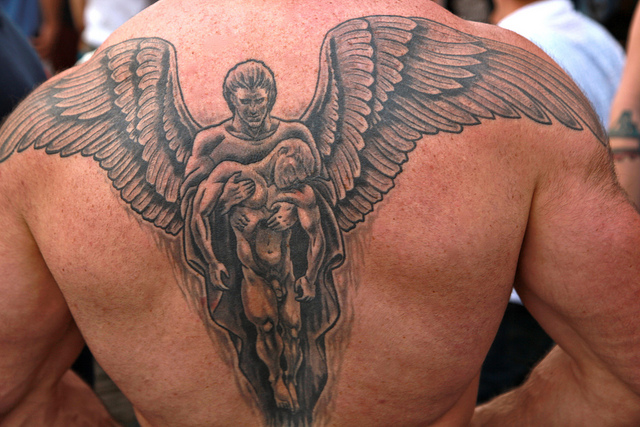Mike is an A-hole. He is a six-foot three, two hundred and fifty pound U.S. Army Veteran A-hole.
He drives a big mean truck with a bumper sticker that reads “Caution: This veteran is heavily medicated for your protection.” He has a gun in the glove box and is one horn honk or middle finger away from a serious road rage incident.
Mike doesn’t sleep much, his chronic back pain keeps him up. He starts his days tired and pis*ed off. He yells at his son for not feeding the dog, argues with his wife about a parent teacher conference, then, storms out of the house, slamming the door, just to fight traffic to get to work. Mike is an A-hole.
But truthfully, Mike is not an A-hole. Mike is a hero.
Mike’s convoy in Iraq was hit by a road-side bomb. His vehicle was destroyed, he broke his back in several places and suffered severe burns while trying to rescue his fellow soldiers from the burning truck. Mike was the only one of his team to survive the attack.
I have the honor of sharing my practice and teaching yoga and mindful resilience at healing retreats for Veterans and Service Members suffering from symptoms of PTSD (post traumatic stress disorder.)
Mike and I were walking to the beach for a meditation session one morning and with tears in his eyes he told me these stories. He said, “I don’t want to be an A-hole, I just don’t know how to not get angry anymore.”
Mike told me that he wished he had lost an arm or a leg so that people could see his injuries. After multiple surgeries to fix his back, Mike still has pain, but the anxiety and anger symptoms of his PTSD are what afflict him most.
“I’m already at like a “7” with my anxiety and anger before I even get to work.” (Patients often use a 1-10 scale describe pain/anger/anxiety/etc.) He said that the breathing techniques and meditation help, but sometimes it’s just too late and they don’t have the effect he knows they can.
I asked Mike, how would you like to start your day at a “2” or “3”? He said that would change his life forever.
Earlier during the retreat, we practiced a basic pranayama (breath control) exercise called the three-part breath, a deep breathing relaxation technique.
Most of us don’t breathe properly, we breathe only into our chests. This is also a symptom of stress and anxiety felt by PTSD patients.
This breathing technique reduces your stress level by activating your parasympathetic nervous system (PNS), your body’s “rest and digest mode.” The deep inhale and long, slow, exhale sends signals to your brain that it’s ok to relax, to release, to let go.
The PNS is our body’s way of turning off the Sympathetic Nervous System (SNS), our body’s “fight or flight” mode.
Veterans with PTSD have a very difficult time turning off their fight or flight mode. Their combat experiences teach them to always be on guard, hyper-vigilant, or you will die. Constant activation of the SNS has many negative effects on the body including insomnia, anxiety, depression, and anger.
To practice the three-part breath, do the following:
First, lay down comfortably. Rest one hand on your belly on top of your belly button. Rest your other hand on your chest. Inhale slowly and deeply through your nose. Direct the air down into your low belly feeling your hand rise. Let the air fill up to and expand the ribs, and finally up to the chest feeling your other hand rise. Exhale longer and slower, releasing the air, allowing the belly to deflate, then the ribs, then the chest. Notice your natural respiratory pause. Repeat.
Mike had a great three-part breath practice and said it helped him manage his stress and anger levels. I told Mike, start your day with a three-part breath. Why wait until things get all spun up to use your breath to calm down? Start that way.
I have used this simple practice with great success in my own life. Every day when I am lying in bed after waking up, but before getting up, I lie on my back, one hand on my belly, the other on my chest. I do three, three-part breaths. Then, and only then, do I get up and start my day.
Mike did this for the remaining days of the retreat and told me that it really helped him start his day with less anxiety and anger. He told me he will do this for the rest of his life because, “it’s so simple, and it works.”
Starting our day with three, three-part breaths is a good practice but it is a useful technique that can be used anytime, anywhere.
When life’s stressors kick in, at work, at home, anywhere, pause. Do three, three-part breaths, and move on. Our breath is an awesome tool that we always have with us and we can use to help keep our minds clear, focused, and relaxed.
Stress, anxiety and anger afflict all of us at times in our lives. We can all benefit from a daily, morning, three-part breath practice. If it can help Mike, it can help us too.
Author: Brian Cooke
Editor: Sara Kärpänen
Photo: Torbakhopper / Flickr







Read 0 comments and reply